Creating a Respectful Culture in a Classroom Peer Reviewed
Critical Practices for Anti-bias Pedagogy
Classroom Culture

vi. Honoring Student Feel
When asking students to explore bug of personal and social identity, teachers must provide safe spaces where students are seen, valued, cared for and respected. It is besides important that students have opportunities to learn from one another's varied experiences and perspectives. To create this learning surround, teachers need to skillfully draw on educatee experiences to enrich the curriculum.
Teachers can prove they value students' lives and identities in a diversity of means. Some are small, like taking the time to learn the proper pronunciation of every student's name or getting to know young people'southward families. Others crave more than time and investment, similar building curriculum effectually personal narratives or incorporating identity-based responses into the study of texts. At the community level, information technology is important to understand neighborhood demographics, strengths, concerns, conflicts and challenges. Similar students themselves, these dynamics may change frequently.
For teachers whose experiences differ from those of their students, information technology is critical to exercise sensitivity. They must bring the following to the try:
- An nugget-based view of youth and unfamiliar identity groups
- A delivery to avoiding and challenging stereotypes
- A sense of openness and cultural humility
- A willingness to let students ascertain their ain identities
Connection to Anti-bias Pedagogy
Honoring student experience supports iii of the four anti-bias domains: Identity, Diversity and Activity. Students who feel their experiences are unwelcome, judged, stereotyped, disrespected or invisible find it extremely difficult to engage in meaningful discussion of identity and justice problems. Those whose stories and voices are heard and reflected in the classroom are more likely to engage with anti-bias curriculum and translate their learning into action.
Knowing and valuing students' lives provides other benefits:
- Ability to identify potential "hot spots" on key topics.
- Development of caring student-teacher relationships that support constructive identity-based learning.
- Development of intergroup awareness and understanding.
- Direction in the selection of texts that are relevant to a detail form.
- Appreciation of student contributions to discussions.
Strategies
Classroom-Cogitating Texts Coupled with Nonjudgmental Dialogue
Choosing texts that reflect classroom demographics and post-obit the readings with discussions or reflective writing assignments tin can provide teachers with powerful data nearly their students' hopes, concerns, strengths and life circumstances. These practices also open channels of understanding among students. Successful conversations about issues of identity oftentimes atomic number 82 to deeper dialogue nigh students' ain backgrounds and the experiences of others.
Share Stories That Make Room for Pupil Sharing
Personal anecdotes—respectfully and thoughtfully shared by teachers—have peachy ability. Stories should be chosen carefully, kept cursory, and told at a level that invites appropriate student sharing.
Community Written report or Educatee-Led Walking Bout
Community studies usually accost up to three questions; structure tin vary greatly and may involve research, interviews, art, writing, video or other media. A walking bout should too focus on a few themes and ask students to highlight neighborhood places they find meaningful in relation to a relevant social outcome. Pupil age and concrete limitations should be taken into consideration when planning a walking tour.
7. Thoughtful Classroom Setup and Structure
Without proverb a discussion, classrooms send messages about diversity, relationship building, communication and the roles of teachers and students. Consider the different messages sent by these two classrooms:
Classroom 1
Desks are arranged in a U shape. The teacher'southward desk is in the front center of the room. On the wall is a poster of U.S. presidents, a re-create of the Declaration of Independence and inspiring quotes from Winston Churchill, Robert F. Kennedy and Albert Einstein. Students are working quietly on an contained consignment.
Classroom 2
Desks are arranged in clusters of four with students facing one some other. The instructor's desk-bound is in the back corner of the room. On the wall is a display of pupil self-portraits, a copy of the Universal Declaration of Homo Rights and inspiring quotes from Maya Angelou and César Chávez. Students are working with their table-mates on a group project.
Classroom setup should be pupil centered. Specifics volition vary from teacher to instructor and class to class, but common elements include these:
- Classroom milieu. Classrooms should be busy with multicultural images that mirror student backgrounds and showcase the diversity of our society.
- Arrangement of article of furniture and supplies. The arrangement volition look different depending on age group and subject, simply all teachers can draw on these goals when setting upwardly a classroom: supporting collaboration, fostering dialogue, encouraging buying and ensuring comfort.
- Student roles and responsibilities. Classrooms will exist near effective when structured to maximize educatee voice and participation.
- Classroom norms. Norms and expectations should take into account different cultural and communication styles, as well as gender differences, language needs and the want to challenge stereotypes. Students should be involved in setting classroom norms to generate purchase-in.
Connection to Anti-bias Pedagogy
Thoughtful classroom setup and construction supports two of the four anti-bias domains: Diversity and Justice. A welcoming class space sets the tone for participatory date. Diverse images affect students' conscious and subconscious understanding of classroom values. Expectations and practices that award diverse backgrounds too create a more just and equitable educational experience.
Strategies
Classroom "Audit"
A (nonjudgmental) classroom audit involves "reading" the letters conveyed past the images on the walls, the books on the shelves and the arrangement of the furniture with an centre toward variety, equity and student empowerment. The inspect too includes considering the types of interactions that teachers accept with students and that students accept with one another.
Student Jobs and Ownership of Classroom Space
Many daily tasks can exist done by students who, given the opportunity, may create new and interesting ways to arroyo them. Real-world lessons related to work and responsibility tin be reinforced in a classroom. Students can apply for a position and be rewarded or promoted for a chore well done. Some classroom jobs might involve passing out materials, documenting or taking notes, managing a classroom library, filing papers or helping with a message board. The job of "peacemaker" can work nicely in classrooms where students accept been trained in conflict resolution. Jobs in a responsive classroom can conform multiple learning styles such every bit artistic, kinesthetic and verbal.
Gender-Neutral Practices
Many teachers, particularly at the simple level, seat or grouping students along gender lines. Yet, not everyone fits traditional gender categories. Some students may feel they are truly a unlike gender than their physical bodies suggest; others might not fit neatly into either the male or female person identity category. Using gender-neutral categories or allowing students to choose the grouping with which they place affirms the experiences of all students.
8. Shared Inquiry and Dialogue
Differences shape who we are and what we know. Life, history, society and ability cannot exist understood from a single perspective; we need multiple viewpoints to truly see the world. Because of this, inclusive classrooms must function as learning communities built on shared inquiry and dialogue.
Dialogue is more than than conversation. It is likewise unlike than contend, in which someone wins and someone loses. Dialogue requires openness to new ideas and collective learning. This is not an easy practice; for students (and teachers) to appoint in dialogue, they must build and practise specific skills:
- Listening. Securely listening to what others say and to the feelings, experiences and wisdom backside what they say.
- Humility. Recognizing that, yet passionately we concord ideas and opinions, other people may concur pieces of the puzzle that we don't.
- Respect. Trusting the integrity of others, believing they take the right to their opinions (even when dissimilar from your own) and valuing others enough to adventure sharing ideas.
- Trust. Building a safety space to explore new ideas and work through conflicts, controversy and painful moments that may arise when talking about problems of injustice and oppression.
- Voice. Speaking the truth as we encounter it and asking questions about things nosotros don't know or understand, specially on topics related to identity, ability and justice.
Connection to Anti-bias Instruction
Shared inquiry and dialogue support ii of the four anti-bias domains: Multifariousness and Action. Building the skills necessary to explore multiple perspectives fosters disquisitional thinking, complex textual agreement and appreciation for diversity. Dialogue as well supports active listening, respectful sharing and conflict resolution. A culture of shared inquiry offers a lived instance of meaningful collaborative work and a model for community building.
Strategies
Naming Shared Research as a Goal
Because many students experience classrooms that do not value shared enquiry and dialogue, it is important for teachers to create a safe environment before request students to appoint in this work. Safety can be established by discussing principles of date, demonstrating the teacher's delivery to collective learning or creating a prepare of discussion agreements.
Teaching Agile Listening Skills
Agile listening is a way of hearing and responding to another person that requires the listener to stop thinking about his or her ain ideas and focus on the speaker. Agile listening behavior includes asking good questions, listening without judgment and paraphrasing. These behaviors can be modeled through the use of talking circles or ordered sharing. Curt practice activities can likewise strengthen agile listening skills.
Rethinking Participation Norms
To well-nigh teachers, form participation means contributing to discussions, volunteering to answer questions or otherwise engaging in verbal exchanges. However, participation does not have to be verbal; gender, culture and ability may impact educatee comfort levels with verbal communication. Modeling disinterestedness and inclusiveness calls for a broader definition of participation that includes active listening, written response, artistic response and involvement in small groups. These options should all be valued as classroom participation.
Addressing Conflicts and Hurt Feelings
Teachers need to prepare for possible conflicts or hurt feelings when exploring personally or politically sensitive cloth. Teachers can encourage students to publicly or privately name "ouch moments"—times when comments or reactions (commonly unintentional) cause upset or discomfort. It is also helpful for teachers to check in with students who seem upset as a result of a grade activity or chat.
ix. Social and Emotional Safety
Social-emotional learning, respect and rubber are as important equally literacy and disquisitional thinking skills when exploring an anti-bias curriculum. Enquiry shows that students need to feel both physically and emotionally safety to acquire. This includes safety from stereotype threat, harassment and exclusion.
Creating a prophylactic climate takes time and work. These are some of the most important components:
- Active teaching of social-emotional skills
- Attending to creating positive relationships
- Bullying prevention and intervention
- Community edifice
- Explicit focus on understanding and appreciating differences
- Meaningful conflict resolution
- Educational activity students to challenge bias and exclusion
- Upstander training
Work on classroom climate and social-emotional learning cannot only focus on empathy, kindness and inclusion. Social difference and bias underlie many unsafe and exclusionary behaviors; these problems demand to exist discussed explicitly. Appreciation for multicultural perspectives is as well disquisitional when instruction virtually relationship building, conflict management and community. This helps students learn to draw on many traditions and experiences and accost social divisions in the classroom.
Connectedness to Anti-bias Education
Prioritizing social and emotional prophylactic supports three of the four anti-bias domains: Identity, Diversity and Action. This practice supports a classroom community in which students experience secure enough to engage in respectful, productive conversations about identity and diversity. This work also models actions necessary to nurture inclusive, respectful connections beyond lines of difference.
Strategies
Classroom Contracts

A contract of norms and behaviors tin can assistance ascertain the classroom community every bit a socially and emotionally safe place. Students should participate in shaping the contract, identifying a list of agreements about how grade members volition treat 1 another, talk together and then on. Bug such as identity, departure and ability should be addressed explicitly. For example, a contract could include "Heed with respect to the experiences of others," "Effort to understand what someone is maxim earlier rushing to judgment" or "Put-downs of any kind are never OK."
Explicit Anti-bullying or Customs-Building Curricula
Many powerful anti-bullying and community- building curricula, when integrated into the regular school curriculum, can build social-emotional skills and teach students to manage disharmonize. Below are a few suggested resource. Not all accost variety or bias issues specifically; be sure to add together these problems to the existing materials if they're missing.
- Tribes Learning Customs. Research-based approaches to classroom and school-broad customs building, social-emotional pedagogy and the development of positive learning communities (all grades).
- Respect for All Project (GroundSpark). Honour-winning films, curriculum guides and teacher training on issues of bias-based bullying, family diversity, gender role expectations and LGBT inclusivity (all grades).
- Steps to Respect/Second Step (Committee for Children). Research-based social-emotional learning and bullying-prevention programs (pre-One thousand through center schoolhouse).
- Bullied: A Student, a School and a Example That Fabricated History (Learning for Justice). Documentary and teaching guide about one pupil's ordeal at the hands of anti-gay bullies and his fight against hate and harassment (eye and high school).
- A Guide to the Film Bully by Lee Hirsch (Facing History and Ourselves). Film and discussion guide on bullying and its profound touch on on several different students and families (middle and high schoolhouse).
Participation in Mix It Up at Luncheon Twenty-four hour period

Mix It Up is a Learning for Justice program designed to help students place, question and cross social boundaries. Launched in 2001, Mix Information technology Up recognizes that some of the deepest social divisions in schools are found in the deli. Each fall, Learning for Justice sponsors a national Mix It Up at Lunch Day when schools around the land encourage students to movement out of their comfort zones and share a meal with peers who are dissimilar from them.
10. Values-Based Behavior Management
Discipline and behavior management are fundamental to classroom culture. How are students encouraged to treat i some other? What happens when they make poor choices or present behavioral challenges? What shapes student-teacher interactions? And what happens when conflicts ascend?
This critical do asks teachers to think well-nigh behavior management in light of 5 primal principles:
- Belief in the dignity of every person
- Community building
- Disinterestedness and fairness
- Respect for cultural differences
- Respect for the safety and inclusion of all individuals and groups
These values can be creatively infused into disciplinary practices. However, in general, responsive classrooms address three key aspects.
Offset, behavior direction systems must support safe, inclusive communities past enforcing high standards for respectful interaction; incorporating student-generated discipline policies; teaching conflict resolution; and actively addressing all instances of bias, bullying, exclusion or disrespect.
2d, disciplinary incidents must become beyond penalization and be treated as opportunities for growth, restitution and community building. This is not to say that rules violations should not be met with consequences. Still, if customs respect is to be a core classroom value, students should non be cast out of the group, even if they struggle to live up to expectations.
Finally, beliefs direction practices must reflect fairness, equity and cultural awareness. Research shows that students of color and special education students face up asymmetric rates of discipline, interruption and expulsion. These patterns take devastating social consequences. Applying disciplinary rules fairly requires cocky-awareness and willingness to append judgment (positive as well as negative) about individual students. Culture besides plays a role in disciplinary judgments; in some cases, "inappropriate behaviors" may reflect a cultural mismatch betwixt the norms of the school and the norms of a educatee'south home civilization. Teachers tin better empathise the relationship betwixt culture and discipline by working on a related disquisitional practice: cocky-awareness and cultural competency.
Connection to Anti-bias Education
Taking a values-based arroyo to behavior management and discipline supports one of the four anti-bias domains: Justice. This practice exposes students to community-building goals and to a system of justice that values all people and builds connections rather than creates divisions.
Strategies
Educatee-Generated Agreements and Contracts
Involving students in the design of classroom subject policies can go a long fashion toward establishing purchase-in and shared ownership of classroom civilization. Ideally, students volition work on the policies equally a grade, merely teachers can also work individually with students who need actress support.
"Zero Indifference" but Not Zero Tolerance

Although nix-tolerance policies are popular, mounting evidence suggests that this approach does not make schools safer. An alternative (recommended by the American Civil Liberties Union; GLSEN; the Anti-Defamation League; the Respect for All Project; and Learning for Justice) is taking a "goose egg-indifference" approach to bullying, harassment and other disciplinary issues. Cipher indifference means never letting disrespectful bear go unaddressed; school staff always proper name and respond to behaviors, just they do not implement automatic suspension, expulsion or other punishments.
Restorative Justice

Restorative justice is an approach to schoolhouse discipline (and criminal justice) that emphasizes repairing impairment and restoring relationships rather than simply punishing those who accept engaged in misconduct. Restorative justice spans a wide variety of practices and strategies, including peacemaking circles, peer jury processes, mediation, conferencing and classroom discussions focused on building empathy.
Source: https://www.learningforjustice.org/magazine/publications/critical-practices-for-antibias-education/classroom-culture
Post a Comment for "Creating a Respectful Culture in a Classroom Peer Reviewed"